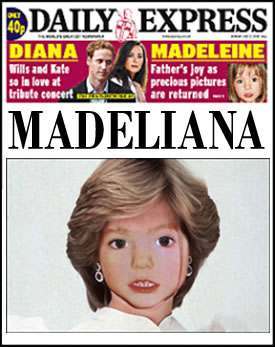How Madeleine McCann Became A Fictional Character Called ‘Our Maddie’
 MADDIE WATCH – Anorak’s at-a-glance guide to press coverage of Madeleine McCann: Writing in the Guardian, Esther Addley names Our Maddy one of the “Icons of the decade”.
MADDIE WATCH – Anorak’s at-a-glance guide to press coverage of Madeleine McCann: Writing in the Guardian, Esther Addley names Our Maddy one of the “Icons of the decade”.
It’s the unsettling mix of the incredibly intimate and the coolly tactical that has made the mystery of Madeleine McCann the biggest and most extraordinary child abduction story in history
No. It isn’t. The disappearance of Madeleine McCann is notable for one thing: the media feeding frenzy. The story itself has one thread: child goes missing. It is a newsworthy event but not the “most extraordinary child abduction story in history”.
The media was attracted not only to the story but to the people involved: middle class, photogenic, erudite professionals. And it helps that Our Maddie is blonde. Addley is right when she says:
Madeleine’s distinctive eye has been central to the search for her since the earliest days. The couple released posters in English and Portuguese in which the letter “o” had been modified to have the same distinctive flash. “Look into my eyes,” read the images: “Olha para os meus olhos.”
Madeleine McCann became a media sensation and a brand. And the parents, savvy media operators, knew its value:
Late in 2007, Gerry McCann gave an interview to an American magazine and talked about the decision to publicise the eye defect. “Certainly we thought it was possible that [the publicity] could possibly hurt her or her abductor might do something to her eye . . . But in terms of marketing, it was a good ploy.”
What it has not done is find Madeleine McCann. The successful marketing ploy, the international campaign to find one missing child, has been a failure. But the single-thread story of Our Maddie, her name itself a media creation, became a thing owned by the press and broadcasters as soon as the McCanns brought in the PRs.
We began to watch the parents. We were invited to. The apparent sightings of the child were part of the show. We didn’t look for Our Maddie – we’d never met her. She existed only in video and pictures. She was not real. But we could watch the parents. The press wanted something to happen. It found people to point the finger at and libel: Robert Murat and the McCanns themselves. Our Maddie was absent from her own story and it didn’t matter.
It is this unsettling mix – of the incredibly intimate and the coolly tactical – that has made the mystery of Madeleine McCann arguably the biggest and most extraordinary child abduction story in history. HL Mencken, the great American essayist and reporter, called the 1932 disappearance of the baby son of aviator Charles Lindbergh “the biggest story since the Resurrection”, but neither the Lindbergh baby kidnap and murder, nor Christ’s rising from the dead, took place in the internet age.
At the story’s apogee, Anorak was getting over 1,000 comments a day for every Our Maddie post. But the comments were in the main against the McCanns or commiserating with them. Not a single person offered a clue, evidence or a confession. What the internet allowed was for the trolls – people who found the disappearance of a child entertaining; who saw it as chance to be heard, however speculative and spiteful their opinions; who were unable to separate fact from fiction – to play armchair detective.
And Our Maddie on the web is no more real than any other celebrity:
Britney Spears was the subject of more internet searches than anyone else this decade, according to research…Osama bin Laden takes second place, with a spate of online searches following the September 11 terror attacks, followed by David Beckham. Princess Diana is fourth, followed by Tony Blair, Madonna, Simon Cowell, Jade Goody, Madeleine McCann and Brad Pitt.
Stick the names together into a list and see them all as the entertainers of the age, the people who kept things interesting and broke up our day. Each something to have an opinion on. But not one affecting us in any way. Just entertainment.
In the case of Sarah Payne, snatched and killed in July 2000, or of Milly Dowler, who vanished in March 2002, or of Holly Wells and Jessica Chapman, who died five months later, the threat was external and unforeseen. Baby P, who died three months after Madeleine vanished, was murdered in circumstances of unambiguous evil. Terribly unjust as it may be, Madeleine’s parents’ dreadful victimhood was complicated, in the mind of the public, by their parenting decisions. It set in play the circumstances that allowed their critics, for a time at least, to judge them more harshly than whoever snatched her.
Because they were so visible. Because Madeleine McCann became Our Maddie, a media creation…
Posted: 23rd, December 2009 | In: Madeleine McCann Comment (1) | TrackBack | Permalink


